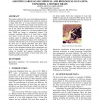Free Online Productivity Tools
i2Speak
i2Symbol
i2OCR
iTex2Img
iWeb2Print
iWeb2Shot
i2Type
iPdf2Split
iPdf2Merge
i2Bopomofo
i2Arabic
i2Style
i2Image
i2PDF
iLatex2Rtf
Sci2ools
99
Voted
VIIP
2001
2001
Aligning Large-scale Medical and Biological Data Sets: Exploring a Monkey Brain
This project addresses the issue of developing interactive rendering methods for datasets which cannot be stored on a single hard drive or in main memory anymore. Our dataset is a set of 1400 slices (single cross-sections) of a monkey brain, which has been sliced more than 15 years ago at the Center for Neuroscience at UC Davis, and recently has been scanned at a very high resolution (more than 10MB per image in compressed format). The enormous resolution allows us to zoom from a global view down to the cell level, all in one image. This exciting range of rendering options requires scalable, multiresolution rendering techniques. The challenges we encounter with this data set is an extreme misalignment of the slices due to manual placement onto glass object carriers and manual insertion in the film scanner. We present a semi-automated method which compensates for most of these artifacts and identifies those slices that cannot be handled and aligned automatically. The algorithm reduces ...
Image Processing | Interactive Rendering Methods | Multiresolution Rendering Techniques | Single Hard Drive | VIIP 2001 |
| Added | 31 Oct 2010 |
| Updated | 31 Oct 2010 |
| Type | Conference |
| Year | 2001 |
| Where | VIIP |
| Authors | Dmitry Shulga, Joerg Meyer |
Comments (0)

